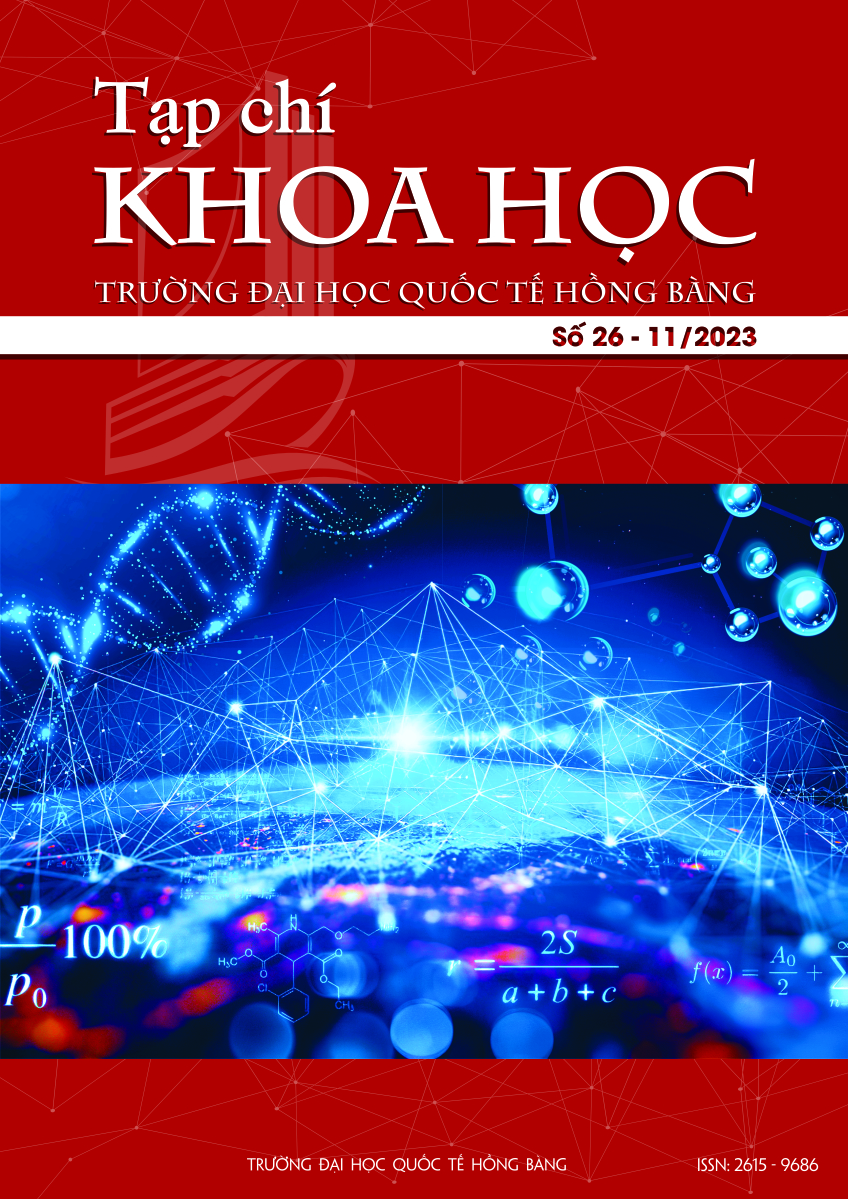Công thức và đánh giá hoạt tính hạ đường huyết viên nhai cao chiết nước ép củ Gừng tươi (Zingiber officinale) ở Việt Nam
Các tác giả
DOI: https://doi.org/10.59294/HIUJS.26.2023.526Từ khóa:
Gừng, Zingiber officinale, viên nhai, tối ưu hóa, RSMTóm tắt
Thân rễ Zingiber officinale thường được gọi là Gừng, thuộc họ Zingiberaceae là một trong những loại dược liệu quan trọng nhất với phổ hoạt tính sinh học rộng và là loại gia vị phổ biến cho nhiều loại thực phẩm và đồ uống vì vị cay nồng và thơm đặc trưng. Gừng đã được sử dụng rộng rãi tại nhà từ thời cổ đại để điều trị nhiều bệnh bao gồm đau, viêm, hen suyễn, ho, đánh trống ngực và rối loạn tiêu hóa. Mục đích của nghiên cứu là phát triển công thức viên nhai hiệu quả từ cao chiết nước ép củ Gừng tươi ở Việt Nam bằng phương pháp bề mặt đáp ứng (RSM). Viên nhai Gừng (100 mg) được bào chế bằng phương pháp nén trực tiếp sử dụng tá dược siêu rã crospovidon (CP). Hai mươi công thức được chuẩn bị và hỗn hợp bột được đánh giá các thông số trước khi nén bao gồm góc nghỉ, tỷ trọng khối, tỷ trọng riêng hạt, chỉ số nén và chỉ số Hausner. Các viên nhai có công thức này được đánh giá về sự thay đổi trọng lượng, độ cứng, độ mài mòn và độ rã. Kết quả cho thấy tất cả các thông số vật lý đều nằm trong giới hạn cho phép của Dược điển Việt Nam V. Công thức viên nhai tối ưu với thời gian rã tối thiểu bao gồm 45.945% MCC (cellulose vi tinh thể), 2.462% CP và 1.951% PVP-K30 (polyvinyl pyrrolidon K30). Hơn nữa, viên nhai và cao chiết nước ép củ Gừng tươi thể hiện hoạt tính ức chế α-glucosidase in vitro tiềm năng với IC50 = 76.4-79.1 µg/mL so với thuốc đối chiếu acarbose (IC50 = 131.6 µg/mL). Tóm lại, việc áp dụng cách tiếp cận RSM đã phát triển thành công viên nhai gừng, có thể mang lại nhiều ưu điểm khác nhau với phương pháp sản xuất đơn giản và hiệu quả về chi phí.
Abstract
Zingiber officinale rhizome generally known as Ginger, belonging to the family Zingiberaceae is one of the most important medicinal herbs with a wide spectrum of biological activity and a common condiment for various foods and beverages for its characteristic pungency and piquant flavor. Ginger has been widely employed in home remedies since antiquity for many ailments including pain, inflammation, asthma, cough, palpitation, and gastrointestinal disorders. The study's aim was to develop an effective formulation of chewable tablets from the extract of fresh ginger juice in Vietnam using response surface methodology (RSM). The Ginger chewable tablets (100 mg) were prepared by direct compression method using crospovidone (CP) super-disintegrant excipient. Twenty formulations are prepared and the blend is evaluated for pre-compression parameters including angle of repose, bulk & tapped density, compressibility index, and Hausner's ratio. These formulated tablets are evaluated for weight variation, hardness, friability, and disintegration. The result showed that all the physical parameters were found within acceptable limits of Vietnam Pharmacopeia V. The optimal tablet formulation for minimal disintegration time consisted of 45.945% MCC (microcrystalline cellulose), 2.462% CP, and 1.951% PVP-K30 (polyvinyl pyrrolidone K30). Furthermore, chewable tablets and fresh ginger extract exhibited potential in vitro α-glucosidase inhibitory activity with IC50 = 76.4-79.1 µg/mL compared to the acarbose reference drug (IC50 = 131.6 µg/mL). In conclusion, the application of the RSM approach successfully developed Ginger chewable tablets, which can offer various advantages in terms of cost-effectiveness and simple manufacturing methods.
Tài liệu tham khảo
[1] P. C. Em, V. V. Lenh, N. V. Cuong, N. D. Ngoc Thoi and L. T. Tuong Vi, “Formulation development, optimization, in vivo antidiabetic effect and acute toxicity of directly compressible herbal tablets containing Merremia tridentata (L.) extract,” J. Drug Deliv. Sci. Technol., vol. 84, p. 104445, 2023. DOI: 10.1016/j.jddst.2023.104445.
DOI: https://doi.org/10.1016/j.jddst.2023.104445[2] P. C. Em, V. V. Lenh, N. V. Cuong, N. D. Ngoc Thoi, L. T. Tuong Vi and T. N. Tuyen, “In vitro and in vivo antidiabetic activity, isolation of flavonoids, and in silico molecular docking of stem extract of Merremia tridentata (L.),” Biomed Pharmacother., vol. 146, p. 112611, 2022. DOI: 10.1016/j.biopha.2021.112611.
[3] J. Muazu, S. Lame, G. T. Mohammed and S. J. Madu, “Formulation and tableting properties of aqueous extract of fresh ginger (Zingiber officinale) rhizome,” World J. Pharma. Res., vol. 4, pp. 9-18, 2015.
[4] S. M. Ghurghure, M. S. A. Pathan, P. R. Surwase, P. D. Shirure and P. M. Gote, “Formulation and evaluation of chewable tablets containing aqueous extract of Zingiber officinale,” World J. Pharm. Pharmaceu. Sci., vol. 8, pp. 1-10, 2019.
[5] USP USP44-NF39, United State Pharmacopoeia 44 - National Formulary 39, the United States Pharmacopeial Convention, Inc, Rockville, MD, 2021.
[6] K. Slinkard and V. L. Singleton, “Total phenol analysis: automation and comparison with manual methods,” American J. Enol. Viticul., vol. 28, no. 1, pp. 49-55, 1977.
DOI: https://doi.org/10.5344/ajev.1974.28.1.49[7] Bộ Y tế Việt Nam, Dược điển Việt Nam V, lần xuất bản thứ năm. Hà Nội: Nhà xuất bản Y học, 2018.
[8] P. J. Sheskey, W. G. Cook and C. G. Cable, Handbook of Pharmaceutical Excipients, eighth edition. Libros Digitales-Pharmaceutical Press, 2017.
[9] H. A. Muhammad, R. Taha, N. A. Mohammad, G. Sana, E. Khalil, J. Ayman, K. Stan, M. A. Ali and R. Mervat, “Optimization of phenolic content, antioxidant, and inhibitory activities of α-glucosidase and angiotensin-converting (AC) enzymes from Zingiber officinale Z.,” Inter. J. Food Prop., vol. 19, pp. 1303-1316, 2016.
DOI: https://doi.org/10.1080/10942912.2015.1063066[10] M. P. Rani, K. P. Padmakumari, B. Sankarikutty, O. L. Cherian, V. M. Nisha and K. G. Raghu, “Inhibitory potential of ginger extracts against enzymes linked to type 2 diabetes, inflammation and induced oxidative stress,” Int. J. Food Sci. Nutr., vol. 62, pp. 106-110, 2011.
DOI: https://doi.org/10.3109/09637486.2010.515565Tải xuống
Tải xuống: 441











